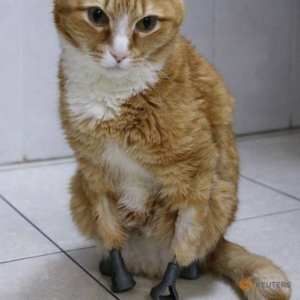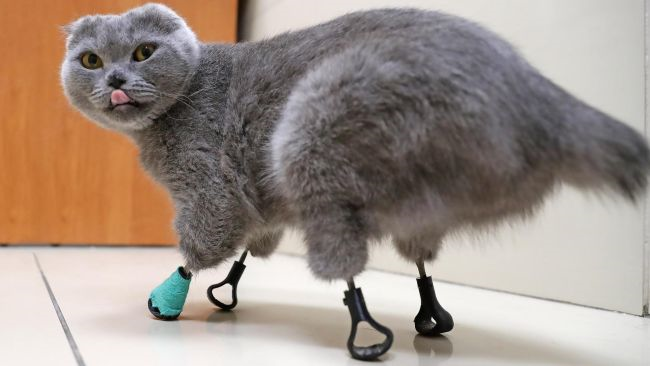We’ve seen cats with 3D printed artificial knees, using 3D printed wheelchairs, and even 3D printed prosthetic legs for cats, but this is a first for me – a Russian veterinarian has given two street cats four 3D printed prosthetic paws each. That’s right – each feline now walks only on 3D printed prosthetics.

Ryzhik the cat, who lost all four paws and got 3D printed titanium prosthetics in 2019, is seen at the veterinarian clinic in Novosibirsk, Russia February 2, 2020. (Image: REUTERS/Vladislav Nekrasov)
The first is Ryzhik, which is Russian for “red” or “ginger.” A few years ago, animal protection volunteers found the red tabby wandering the icy streets of Tomsk in Siberia, with all four of his paws frozen; he would have died if they hadn’t rescued him. They then traveled 130 miles to bring him to veterinarian Sergei Gorshkov at his clinic in Novosibirsk.
“Generally these cats try to keep themselves warm and stand up on the tips of their paws. Their paws, ears, noses and tails can freeze,” Gorshkov said.
He explained that during the freezing Siberian winters, his clinic typically treats at least five to seven cats due to frostbite in their paws, ears, and noses. In more severe cases, the tissue can die and must be amputated. This is what happened to Ryzhik – all four of his frostbitten feet had to be removed. As heartbreaking as this is, Gorshkov had a plan to help him walk again, using 3D printed titanium implants.
According to the veterinarian, Ryzhik is one of the world’s first cats to have four titanium paws implanted into his bones using a technique that’s similar to giving humans dental implants. The second is four-year-old Dymka, which means “mist” or “haze” in Russian. The silky gray female was found in Novosibirsk by a passing driver in the snow, who brought her to Gorshkov.
“There are two likely scenarios: Either she ran away or she fell out of the window. Unfortunately, frostbite in animals is a very real problem in Siberia,” the veterinarian said last summer after she was found.
In addition to losing all four of her feet, poor Dymka also had her ears and tail amputated due to the frostbite. He could have euthanized her, but Gorshkov doesn’t shy away from a challenge. The veterinarian and his colleagues worked with the BEST Veterinary Clinic and researchers from Tomsk Polytechnic University to create 3D printed prosthetics for her.
CT X-ray scans were used to model and 3D print the titanium rod implants for the cat, which were then inserted and fused into her leg bones. The team also created, and applied, a bio-coating of calcium phosphate to help minimize the risk of rejection and infection, as well as mount the implants into her leg bones. The implants end in “feet” with textured bottoms, made of flexible black material for easy movement.
Dymka received her 3D printed prosthetic implants this summer, with the front legs implanted first and the hind legs following a few weeks later. The clinic posted a video recently – seven months after her new paws were attached – that shows the cat is doing just fine.
“She runs, jumps and plays. Her owner sends videos of how she moves. It’s a great result. We are very pleased. We did not expect this,” Gorshkov said.
She now lives the life a typical house cat 190 miles southeast of Novosibirsk, in Novokuznetsk, with her new owner – the woman who found her in the snow.
According to Novosibirsk News, Dymka and fellow bionic cat Ryzhik met at the clinic while she was being treated, as the orange tabby lives there now after his 3D printed prosthetic paws were successfully implanted. Gorshkov has also created prosthetic paws for small dogs, but did say that the technology does not necessarily apply to any animal that requires an artificial limb.
Discuss this story and other 3D printing topics at 3DPrintBoard.com or share your thoughts below.
The post Russian Cats Walk Again with 3D Printed Titanium Prosthetic Paws appeared first on 3DPrint.com | The Voice of 3D Printing / Additive Manufacturing.











